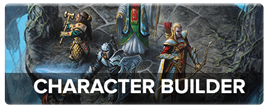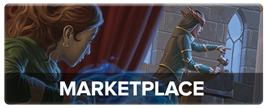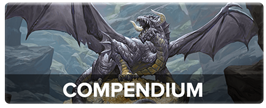When we think of a typical Dungeons & Dragons adventure, what comes to mind are scenes of might, magic, and — well, dragons. But some dangers are not creatures that can be slain. With the upcoming release of Van Richten's Guide to Ravenloft, let's discuss ways to attack your player characters' minds using psychological horror.
First things first: speak to your players
A session zero is designed to have all of the players sit down with one another to discuss what they would like and not like to experience in the upcoming adventure. When it comes to horror, setting storytelling boundaries is important. A player might be uncomfortable with body horror but enjoy folk horror, which explores themes such as paranoia and superstition. Knowing this, you can shape an adventure that can terrify and thrill your players.
The lines between different types of horror can blur. But in general, these are the types of horror and themes outlined in Van Richten's Guide to Ravenloft:
| Type of horror | Example themes |
| Body horror | Physical transformation, anthropomorphism, body swapping |
| Cosmic horror | Alien forces, loss of reality, cults |
| Dark fantasy | Antiheroes, evil in positions of power, moral ambiguity |
| Folk horror | Superstition, lost truths, hidden traditions |
| Ghost stories | Mortality, ancestry, paranormal |
| Gothic horror | Tainted humanity, intense emotions, sense of dread, sacrifice |
| Disaster horror | Societal collapse, region- or world-changing ruin, cannibalism |
| Occult detective stories | Paranormal, noir, supernatural forces |
| Psychological horror | Unreliable narration, paranoia, lost sense of reality |
| Slasher horror | A relentless and nearly unstoppable killer, grisly details |
Ways to bring psychological horror to your game

Take your player characters into a nightmare
When it comes to psychological horror, one way to spook your players is by having them lose confidence in whether their characters are experiencing reality or something else. One way to do this is by taking your player characters into a nightmare. When your player characters take a long rest, you can narrate them waking up in the exact same location that they fell asleep in, but then provide hints that something is off. It can be subtle or overt.
For example, they might leave their room in a tavern and find themselves in an endless hallway. They’ll quickly learn that each door opens into a terrifying memory from a player character’s past. Encourage roleplay by asking each of the players to narrate what their characters witness and how their characters respond.
Here are ways to stress your player characters trapped in a nightmare:
- Take ordinary objects and add a twist: Paintings that subtly move on their own, dolls that move or speak when in the dark, humanoids acting normally despite having mortal wounds
- Turn normally beloved things into something sinister: Enormous babies with insatiable appetites, whispering winds that drown the mind in doubts and fears
- Create dangers far beyond their capabilities: Rooms that fill with a black viscous liquid, a horde of shadows that claw their way forward, an invisible force that crushes anything it comes in contact with and that ceaselessly follows the player characters.
Escaping the nightmare
While in the nightmare, player characters should not be allowed to leave without interacting with their environment. But you should drop hints on how to escape. Perhaps an NPC they encountered the previous day repeated a particular phrase that actually describes a room the player characters must find to discover an exit.
The longer the player characters take to escape, the worse their situation should become. Be open to alternative solutions, however, and be clear that there is an exit. If the players discover that you’ve thrown them in an unwinnable scenario, their motivation to escape could plummet.
I enjoy placing escape routes that are counterintuitive, such as jumping into a “bottomless” pit or doing the exact opposite of what NPCs tell them to do. The solution is most effective if it is something that is hidden in plain sight yet the last thing they might think of.

Turn ally NPCs into secret antagonists
You don’t need to throw your player characters into a nightmare to terrorize them. Deception and misdirection can lead your player characters to question everything. Aspects of the environment should be off-putting but not enough for the party to whip out their weapons.
For example, a doomsayer who is dressed in ragged clothes, smells horrible, and is erratic could warn that there is a conspiracy that a cult runs the town and that the only way to stop them is to destroy a beloved statue to a good-aligned god. Hearing something so outlandish, your adventurers would likely be skeptical, especially if you have a trusted NPC who downplays the warnings.
As the adventure progresses, throw hints that something is wrong. A perceptive player character might notice that the statue has changed positions overnight. Upon sharing this information with others, however, they would discover that the statue doesn't appear to have moved at all. Or the town mayor, who is typically kind and often smiling, could say something jarring and out of character. When asked to repeat themself, the mayor could say something that sounds similar but is entirely reasonable.
Leave your player characters no hard evidence that could prove their sanity. If a player character decides to be rash and make a scene, have the town guard respond reasonably. Your goal is to make the player characters feel out of touch with reality. This constant strife will slowly chip away at the securities of the party until they accept that they are mere flies caught in the web of a deadly spider that has yet to strike.
Here are ways to get your player characters to question their reality:
- Fill the tavern or town with enemies pretending to be allies who always watch the heroes: This will strip the party from the only traditional refuge they have, introducing a feeling of vulnerability.
- Make the neutral or outright evil characters the true allies: A necromancer might try and assist the party in an abrasive manner that gets rejected initially because of their unsavory reputation. In a moment when the party needs aid, the necromancer could return as a potential ally.
- Make the most unassuming or charismatic NPCs the true threat: The fair maiden who begs for help at the start of the adventure could in fact be a vampire trying to lure victims to a dark place where she can feed on them. A sweet old man who needs help clearing out a local band of goblins could have needed their corpses for a ritual.
Discovering the deceivers
The player characters will need to be strategic in discovering and stopping the enemies hiding in plain sight, lest the entire community rise up against them. This could involve infiltrating the town guard that secretly kidnaps victims for sacrifices or searching the town mayor's estate for clues that reveal he's one of several doppelgangers in the area.
Your player characters might choose to simply escape the area, deciding that evil has dug its roots too deep for them to be of any aid. Consider the ramifications of this go this route. For example, the cult might succeed in summoning a devil or the doppelgangers might expand their reach to other settlements.
Adding in-game complications to your adventure
The Dungeon Master’s Guide has a section dedicated to short-term madness, long-term madness, and indefinite madness. The effects of madness can range from becoming paralyzed to being unable to speak normally. The length of the effect is determined by the roll of a 1d10 for short- and long-term madness. These tables can also serve as inspiration for complications your player characters could face when interacting with horrors.
Short-Term Madness
| d100 | Effect (lasts 1d10 minutes) |
| 01-20 | The character retreats into his or her mind and becomes paralyzed. The effect ends if the character takes any damage. |
| 21-30 | The character becomes incapacitated and spends the duration screaming, laughing, or weeping. |
| 31-40 | The character becomes frightened and must use his or her action and movement each round to flee from the source of the fear. |
| 41-50 | The character begins babbling and is incapable of normal speech or spellcasting. |
| 51-60 | The character must use his or her action each round to attack the nearest creature. |
| 61-70 | The character experiences vivid hallucinations and has disadvantage on ability checks. |
| 71-75 | The character does whatever anyone tells him or her to do that isn’t obviously self-destructive. |
| 76-80 | The character experiences an overpowering urge to eat something strange such as dirt, slime, or offal. |
| 81-90 | The character is stunned. |
| 91-100 | The character falls unconscious. |
Source: Dungeon Master's Guide
Curing MadnessA calm emotions spell can suppress the effects of madness, while a lesser restoration spell can rid a character of a short-term or long-term madness. Depending on the source of the madness, remove curse or dispel evil and good might also prove effective. A greater restoration spell or more powerful magic is required to rid a character of indefinite madness.
Go forth, and terrorize your player characters!
Players will be excited to see how their characters will react to a terror-themed adventures! Being unable to merely fireball your problems away can lead them to work together to find more complex solutions. Horror doesn’t have to gory. But it should create lasting tension and occasionally make your players do a double-take.
But again, when exploring horror at your table, it's important that your players feel comfortable with the themes you'll explore. Check in with your players on occasion and be prepared to skip grisly descriptions or alter ideas you had in order to maximize fun at your table.
Van Richten's Guide to Ravenloft is available for preorder now in the D&D Beyond Marketplace! All preorders come with digital dice, as well as character themes, frames, and backdrops!
DeAngelo Murillo is a fourth-generation Mexican-American who helps bring more representation to the geeky community through storytelling, journalism, interviewing creatives, and more on his Twitch channel. In his free time, he enjoys harassing his peers into participating in TTRPG charity events with him and also dies quite often in video games.“











-
View User Profile
-
Send Message
Posted May 17, 2021I am currently writing a campaign for a group of seasoned players set within Ravenloft. All of these tips and suggestions will definitely add to the twists and turns I will be putting them through in the Domain of Dread.
-
View User Profile
-
Send Message
Posted May 18, 2021After reading this post I ditched my old campaign for one like this
-
View User Profile
-
Send Message
Posted May 18, 2021I just offered to do my first DM session and I am now rushing to get my world ready, so guess I will use this
-
View User Profile
-
Send Message
Posted May 19, 2021ah this is perfect. i love these articles dnd beyond puts out for anyone to read through
-
View User Profile
-
Send Message
Posted May 19, 2021Why does Curse of Strahd get mentioned all the time for Horror campaigns, but not Out of the Abyss? [TW for psychological abuse and existential-crisis-inducing subject-matter below]
CoS is classic horror with an added dimension of psychological abuse; the party is stuck in a classic-horror plane and needs to get out or risk either being stuck in barovia, dying there, or suffering a personal fate worse than death. Strahd is a sadistic and manipulative tyrant, but he's still at most just a vampire lord with a demiplane under his control. He's not exactly an existential threat comparable to most of the stuff that adventurers in the Forgotten Realms know about.
OotA is cosmic horror about existential dread and loss of identity and reference through the spread of chaos. The party is stuck in an thoroughly "alien" context with no point of reference for surface-dwellers, and are being hunted by horrible sadistic drow (which can be made comparatively every bit as psychologically-abusive and powerful as Strahd should be) who are themselves threatened by even more horrifying eldritch abominations whose very presence tears reality asunder and who would rend the whole cosmos into utter formless chaos if only left unchecked; ultimately leading to a fate worse than death for the entire universe. It's about the very antithesis of ordered reality breaking out of its containment and being let loose upon the world. Demons Lords are godlike twisted beings of chaos and entropy made manifest, wholly impossible to rationally understand except for the fact that they hate the very existence of the cosmos and everything in it, and that they would see it all uncreated in the most cruel and agonizing ways imaginable.
The lack of attention being put on OotA is a bit of a wasted opportunity.
-
View User Profile
-
Send Message
Posted May 20, 2021This is gonna be fun, TIME TO TERPRIZE!
-
View User Profile
-
Send Message
Posted May 21, 2021ohoho, this is awesome. my party is going to HATE this, thank you so much
-
View User Profile
-
Send Message
Posted May 21, 2021This was awesome and much needed, thank you!
-
View User Profile
-
Send Message
Posted May 22, 2021This would be really fun to do starting with a lawful good character i think. their alignment would be thrown into question so many times xD
-
View User Profile
-
Send Message
Posted May 22, 2021"madness" is a trope in literature... that often has little to do with real world mental illness. I believe the tables in the DMG are filled with the results of the trope... not depression, anxiety, nor manic depressive disorder.
-
View User Profile
-
Send Message
Posted May 23, 2021oh my gosh yes just randomly making players roll for initiative is a great way to freak them out
also the passive perception and HP ones are good too
-
View User Profile
-
Send Message
Posted Aug 4, 2021Wizards of the Coast legit just said 'gaslight your players. Let them be sure of nothing.'
Devious, guys. What a great idea!
-
View User Profile
-
Send Message
Posted Aug 4, 2021definitely.
-
View User Profile
-
Send Message
Posted Aug 4, 2021NOT wizards of the coast.
-
View User Profile
-
Send Message
Posted Aug 5, 2021Yea DndBeyond are not Wizards of the coast.
-
View User Profile
-
Send Message
Posted Apr 19, 2022I win.
-
View User Profile
-
Send Message
Posted Apr 19, 2022I win.
-
View User Profile
-
Send Message
Posted Apr 7, 2023Doppelgängers pretend to be the party and NPCs bring up feats of the party that they haven’t done but was actually the work of doppelgängers trying to replace them.
-
View User Profile
-
Send Message
Posted Dec 2, 2023Well? Did Nelli survive?